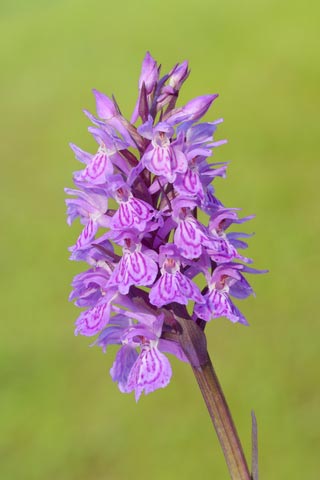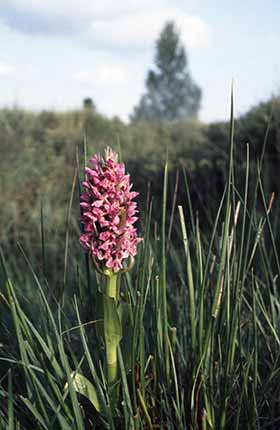Early marsh-orchid and Southern marsh-orchid
(Dactylorhiza incarnata sub-species pulchella and Dactylorhiza praetermissa)
Both early marsh-orchids and southern marsh-orchids can be found in the New Forest, sometimes in good numbers, and always in and around the valley mires. Southern marsh-orchids, however, tend to favour less acid soils than early marsh-orchids.
Early marsh-orchid
When: Mid-May to early July
How many: Relatively numerous and widespread

sub-species incarnata
(courtesy of dreamstime.com)
Rich mauve-purple coloured flowers of early marsh-orchids, sub-species pulchella, are relatively often seen in the New Forest.
The other main sub-species, incarnata, is, however, absent as it grows well only on more calcareous soils.
(These two sub-species are very similar in appearance, although the flowers of pulchella are a richer mauve-purple in colour).
Early marsh-orchid height is usually 10-35 centimetres (4-14 inches). The main flowering period is from mid-May to July.
Southern Marsh-orchid
When: Early June to mid-July
How many: Relatively numerous and
widespread

Southern marsh-orchids can grow to a height of 80 centimetres (32 inches). 20 to 30 centimetres (8-12 inches) is, however, more usual, whilst some in more acid soils do not exceed 10 centimetres (4 inches).
Southern marsh-orchids are usually sturdy, erect plants that in the New Forest usually stand singly or in small groups, proud and aloof amongst sometimes dense, coarse wetland vegetation. Indeed, access for close examination is often not possible, so damp can be the ground underfoot.
The main southern marsh-orchid flowering period is from early-June to mid-July.
Telling Southern Marsh-orchids from Early Marsh-orchids
Identification of these species can be awkward. Both southern marsh-orchids and early marsh-orchids can be somewhat variable in appearance, and they freely hybridise with other marsh orchids and with common spotted-orchids and heath spotted-orchids. Even text books and modern field guides add to the confusion by occasionally listing the plants under different names and with slightly conflicting descriptions which frequently use words such as ‘typically’, ‘usually’, and ‘often’.
How, then, does the relative lay-person best tell southern marsh-orchids from the New Forest variety of early marsh-orchid? Well, the following comparison of key features, taken from the Collins New Generation Guide and from Britain's Orchids by David Lang, should help.
Leaves:
Early marsh-orchid - unspotted, yellow-green leaves, hooded at the tip.Southern marsh-orchid - unspotted, long, spear-shaped leaves.
Flowers:
Early marsh-orchid - rich mauve-purple. The lip is shallowly three-lobed, with the side lobes folded tightly back, making the flower appear very narrow. It is marked with a pronounced red double loop enclosing a series of dots and short lines.
Southern marsh-orchid - varies from pale lilac-mauve to dark magenta. The
lip is broad, scarcely three-lobed and with a pale, central zone marked with small dots and dashes which never form a symmetrical double loop.
References:
Collins New Generation Guide - Wild Flowers of Britain and Northern Europe: Alastair Fitter
Wild Orchids of Hampshire and the Isle of Wight: Martin N. Jenkinson
The Flora of Hampshire: Anne Brewis, Paul Bowman and Francis Rose
Britain's Orchids: David Lang
More links
Other related links
Search this site

Sadly, 58 animals were killed - 35 ponies, 13 cows, 8 donkeys and 2 sheep, whilst a further 32 were injured - 3 pigs, 9 donkeys, 11 cows and 9 ponies.
(Forty-three accidents occurred in daylight, 15 at twilight and 101 in the dark. Twenty-seven accidents were not reported by the driver involved).
Here's just one horrific example - Three donkeys killed in collision with van at notorious New Forest blackspot (Advertiser and Times)

